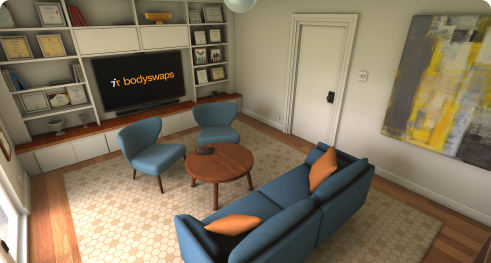Active listening
Tutor notes
Good communication is a two-way street: listening is just as important as speaking. This immersive training module introduces a set of techniques for listening in a way that will help individuals build better relationships with the people around them, and provides a safe space for them to practise these techniques in a virtual environment.
Across the three activities included, learners will explore how to identify good active listening practice, apply the techniques learned, and validate the feelings of their conversation partners in ways they can take with them into their daily lives.
About this resource
Key learner outcome and goals
Learning outcome
Practise active listening techniques to make those around you feel truly heard.
Learning goals
- Distinguish between good and bad active listening practices
- Apply active listening techniques and behaviours
- Use summarising to check understanding and validate the other person’s feelings
A word about terminology
As a medium, Virtual Reality is not best suited to didactic teaching methods.
However, our intention is that all Bodyswaps modules follow a student-centred constructivist pedagogy. This means creating rich experiences in which learners can explore key concepts and ideas and reach their own conclusions.
This is why our documents speak in terms of learning goals and outcomes, rather than measurable ‘learning objectives’ (a la Bloom’s Taxonomy) per se.
Module structure
This 15-minute module takes the learner through three interactive topics, as well as ancillary activities such as onboarding, self-reflection, and the exit survey.
It is a linear experience, meaning the learner will be guided step by step through all the activities.
We recommend that learners fully interact with each activity to get the full benefit.
It is estimated that each topic will take the learner approximately 5 minutes to complete, although completion times vary depending on whether the learner chooses to repeat topics to explore different options (encouraged) or to fine-tune their freeform responses.
Learner journey
.svg)
.svg)
.svg)
.svg)
.svg)
.svg)
.svg)
Characters

Amy
Colleague who needs to work on her listening skillsEnvironments

Tutor room – Bodyswaps HQ

Courtyard
Purpose
Location
Characters
N/A
Journal
Duration
1:00
The first time learners use Bodyswaps, an onboarding sequence familiarises them with the features of the app, takes them through an avatar selection and embodiment activity, and prepares them for the experience to come.
In the onboarding, learners will:
- Find out how this training is different from the rest
- Select their avatar
- Discover their virtual journal
- Learn how to navigate and use the tools and settings
Purpose
Introduce the module and encourage the learner to reflect on their current confidence levels
Location
Characters
Journal
Duration
The learner begins in the tutor room, where they’re introduced to work colleagues Dave and Amy. Dave is feeling frustrated about how he’s been treated at work and is trying to explain it to Amy – who, though well-meaning, isn’t really listening.
The learner’s task is to identify where Amy’s going wrong, then take over the conversation themself and find out what Dave is really trying to say, before using a summarising technique to check their understanding and validate Dave’s feelings.
Once the scenario has been laid out, the learner is invited to complete a series of three Likert-type survey questions gauging their confidence about listening attentively, asking thoughtful questions and summarising the key points of a message. These survey questions will be repeated in the debrief at the end to assess how the learner’s confidence levels have changed.
Purpose
Learn to identify good and bad active listening practices
Location
Characters
Journal
Duration
The scene moves to a courtyard area at Dave and Amy’s workplace, where the learner is sitting at a table with the two of them as they make conversation. It quickly becomes clear that Dave is preoccupied with some unexpected feedback from his manager that he wants to get off his chest, and that while Amy is trying to help in her own way, she doesn’t see what he needs from her at present.
In this observation activity, the learner watches Dave and Amy’s conversation and clicks or taps to identify three good and five bad examples of active listening from Amy. Visual feedback is provided in real time to indicate whether the learner has correctly identified each example.
As the conversation progresses, the learner witnesses how Amy’s initial positive active listening encourages Dave to open up. However, as she makes more missteps, Dave is less and less able to get his message across effectively, and the conversation ends without any resolution when Amy leaves altogether.
At this point, the learner is provided with fuller feedback, allowing them to replay Amy’s good and bad listening practices from Dave’s point of view and see an explanation of how each behaviour could make someone feel heard or ignored, respectively.
Purpose
Learn how to use thoughtful questions as part of an active approach to listen
Location
Characters
Dave
Journal
Duration
Amy has left the courtyard, and now it’s up to the learner to try and handle the conversation with Dave on their own.
In this scaffolded conversation, learners choose how to respond to Dave in a sequence of four multiple-choice exchanges. Each question gives the learner three options to choose from; once they’ve made their selection, Dave responds, after which a popup is shown with more detailed feedback to demonstrate the benefits or drawbacks of the answer the learner selected. If necessary, the learner is given another attempt, so they can find the right answer and see the positive impact of their active listening.
At each stage, the learner needs to select an open question that encourages Dave to explain further and enhance the learner’s understanding, rather than a closed one that jumps to a solution or otherwise wrests the conversation away from Dave. These ideal responses make Dave feel heard and encourage him to continue, while closed questions cause him to become irate or shut down.
After the final question, the opportunity to vent has relieved some of Dave’s tension, and he’s decided what to do next.
Purpose
Learn how to use summary and paraphrase to make a person feel heard
Location
Courtyard
Characters
Dave
Journal
Duration
5:00
Now that Dave has opened up and shared his story, the learner needs to let him know they really heard him and understand how he feels.
This topic opens by introducing a summarising technique that uses paraphrasing to repeat back the speaker’s words, demonstrating comprehension and making them feel heard. The intention is to validate their feelings, check your own understanding, give the other person a chance to reflect, and – if necessary – clarify anything that needs it.
The learner is invited to explore this through a freeform interaction, in which they reflect Dave’s story back to him in their own words. Behind the scenes, analytics tools pick up on the keywords, body language and verbal cues that show the learner has formulated a successful response – using Dave’s name, maintaining eye contact, providing validation and summarising.
Once the learner has said their piece, they swap bodies with Dave to see how their speech looked from his point of view. After that, they receive the feedback from the analytics tools to refine their performance, at which point they can either try again or move on to the debriefing.
Purpose
Debrief the learner upon completion of the training and prompt self-reflection
Location
N/A
Characters
N/A
Journal
N/A
Duration
The training concludes with a reminder of how essential active listening is as a communication skill: it gives the user a better understanding of those they speak to, and makes those people feel valued and appreciated.
After a final congratulation, the Likert-type survey questions from the start of the course are repeated to gauge the change in the learner’s confidence after playing through the module.
Note: With soft skills training, it is not unusual to find that learners’ confidence levels actually fall upon completion. This is because people are often overconfident in their ability to communicate or empathise before the training begins. As the experience raises self-awareness, confidence levels may fall in response.
Purpose
Assess the effectiveness of the training itself
Location
Courtyard
Characters
N/A
Journal
N/A
Duration
Before the learner leaves the module, they are asked to complete a short survey about their experience.
This survey is not compulsory, but the data helps us to assess the effectiveness of our product and identify any areas that need improvement. Clients also find it beneficial when assessing ROI.
They are asked to mark whether they agree or disagree with the following statements, on a 10 point scale:
- I would recommend this experience to colleagues.
- The experience helped me identify elements I could improve upon.
- I now have a better understanding of active listening best practices.
